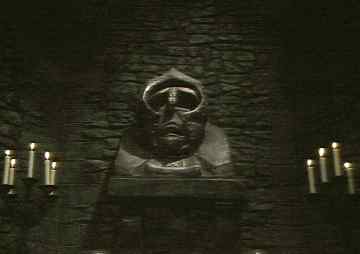
| The crews of Liberator and Scorpio encountered at least 4 religions, past and present, unknown to late twentieth century Earth, that were shown in some detail, described in some detail, or both. Also in the series were references to religions known to late twentieth century Earth, to religion in general, to the Federation's anti-religious policy, to what could be parts of religions, to words and phrases of religious origin, to religious allegiance, and religious comparisons. | 
|
The most detailed religion in the series was the one on Cygnus Alpha. The planet's government was a theocratic monarchy, with secular and religious authority being indistinguishable. The ruling class appeared to be a priestly order, headed by Vargas, who called himself 'the supreme power here. My word is law. My followers obey without question'.
His right to rule was because he was directly descended by 'the true and chosen line' from his great-great-grandfather, the founder of the religion, who 'brought them together in the love and fear of God'. (See MONARCHY.)
There were also sacred places, including the Place of the Novices, the Place of Rebirth, and the Place of Sacrifice, a religious doctrine including prayers such as the First Law (See FIRST LAW.), chanting, and ceremonial robes (Vargas's being purple and Kara's burgundy). Torture, execution, or both appeared to be the fate of those regarded as unbelievers, and its rituals also included human sacrifice.
Vargas wanted the Liberator so that he could spread the religion to other worlds, and was prepared to torture Blake and sacrifice at least one of the London's prisoners to do so.
i. In Deliverance, the Liberator's crew discovered a religion, possibly polytheistic - although it could have been a form of ancestor worship - on Cephlon. Meegat, the latest incumbent in the office of 'the one who waits' for a messianic saviour of her people, acknowledged Avon as such, calling him 'Lord'. She explained to Avon, Gan, and Vila a prophecy that 'strangers not of this world would be the means of our deliverance'. She later spoke of the 'legend of deliverance':
Our fathers fought a great war, and Kashell the Wise dreamed all life would end in this place....So Kashell sought a way to preserve our race. A way for it to survive in a new place among the stars. And the way was found....Deliverance was prepared. And Kashell the Wise was satisfied that it was good....All that was needed to complete deliverance was the word of Kashell. But our fathers killed him, and the word was forgotten. And so we wait for the nameless Lord whose name shall be spoken by the one who waits. Meegat speaks his name. His name is Avon.
'Deliverance' was a chemical rocket in launch position, carrying a cargo of fertility cells. Avon, with Vila and Gan, was able to launch the rocket, fulfilling the prophecy, despite all being uncomfortable with how they were regarded.
Gan and Avon both referred to themselves and Vila as 'gods', indicating that they regarded the religion as possibly polytheistic (if indeed they thought about it to any extent); and this assumption may be correct as Jenna later asked Avon if Meegat really thought that he was 'a god', and received the reply, 'For a while'.
ii. In Dawn of the Gods, the Liberator's crew encountered a being called the Thaarn. (See THAARN.) While Cally said that he was 'as mythical to me as dragons and unicorns are to the people of Earth', and that he 'never existed outside children's stories and legends', she told of 'the oldest story in the Book of Auron'. (See BOOK OF AURON.)
Seven gods, according to her, discovered Auron and left there the first man and woman. They came back after a million years but were 'no older', were 'pleased with what they saw' and bestowed 'great gifts'. One of the gods was 'very jealous', not believing that the people of Auron deserved all this; he was frightened that they would become so powerful that 'they would challenge the supremacy of the gods themselves' and in his rage killed another god. The five remaining gods were so angry that they built 'a chariot for him and sent him beyond the threshold of space and time'.
The 'mad god' swore 'a terrible vengeance', saying that he would return again and discover 'the eternal secrets' and become 'the one great master of the universe'. Cally ended by repeating that the story was 'a legend', and that on Auron the name of the Thaarn was a 'symbol for darkness and evil'.
It is possible that a polytheistic religion was once practised on Auron, but ceased to be so before Cally's time. Perhaps there was an official policy to inculcate in the Auronar that such a faith had been a complete myth, with no basis in fact. Cally's dismissal of the story may have been the product of such a policy. If so, it was ironic that her refusal to admit to a factual basis of that faith appeared itself to have the characteristics of a faith.
iii. The religion shown on Mecron 2 in Games was an important factor in what was seen to happen on the planet. According to Belkov, the Mecronians took their religion 'rather seriously'. Later he spoke of ritual murder being one of their 'rather nasty habits'.
According to him, the Mecronian high priests used necklaces of Feldon crystals as the symbol of their power, using the death of a chief who stole a necklace as evidence that the gods had been angry and struck him down. Belkov, realising that it was an electrical storm, used this legend to 'convince' the people that their gods had sent him to take the crystals, using a remote controlled laser rifle to shoot all, save him, who tried to wear a necklace.
The Mecronians appeared to have a number of sacred places. Belkov deliberately sent Servalan and her men to one such place, saying that the _Scorpio's_ crew were there, ensuring that she would have a fight on her hands. When they went in, there were sounds of chanting and a figure holding up a knife in what was presumably a religious ceremony of some kind.
The fact that the fake Feldon necklace and the knives used by the Mecronians were all in the shape of an equilateral triangle, plus the reference to ritual murder, suggests that the shape may have been a religious symbol.
It was possible that the Federation tolerated its citizens using words and phrases of religious origin, something seen in the series, on the grounds that such words and phrases were sufficiently detached from this origin.
While there were descriptions of and references to religion in the series, it was told from the point of view of the main characters, who were not 'religious' in terms of any declarations of religious allegiance, including stating that they tried to model their outlook and behaviour on the teachings of a religion, or engaging in any acts of worship. Most were either Federation or ex-Federation, and the reference to that state's anti-religious policy might indicate that the passage of time, coupled with this policy, appeared to have produced, even among those who would regard the regime as an enemy, many irreligious people. Gan, in Pressure Point, had to be told by Blake what a church was.
Presumably, those who wanted to have a career in the Federation had to conform, at least outwardly, to this policy, whether sincerely or not. On whether there were underground religions in the Federation, perhaps looking to those based outside that state, no information was given.
The device used by Wallace and Teague to open the hatchway on the outer hull of the Liberator. It was fitted with at least three "circuits", the third of which caused the hatch to open.
| Remote-controlled cameras, hovering some distance above the ground and used for recording and televising events. They could be directed by spoken commands. "Remote" was probably viscast production crew jargon. | 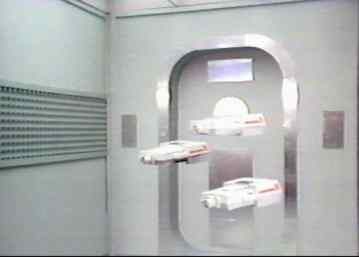 |
Visual projection device on the flight deck of the Liberator. It appeared to deliver a holographic image from a tall conical projector.
| A surgeon based on research station XK-72, Dr Renor teleported across to Liberator to assist Professor Kayn in repairing Gan's limiter. He was prepared to try and operate on Gan unassisted when Kayn sat back and waited for the Federation to arrive. He presumably died when a salvo of plasma bolts missed Liberator and destroyed the station. | 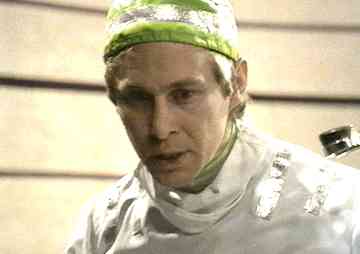 |
The cloning centre on Auron, apparently under the control of Franton. The only other member of staff mentioned was Cally's twin, Zelda. Avon, Tarrant and Cally took temporary refuge in the replication plant when Servalan started bombarding the city - the presence of Servalan's clones meant that no projectiles were fired on the plant. Together with Franton and gene stocks for 5000 offspring, the crew teleported out before Ginka persuaded Servalan to let him open fire on the plant. The replication plant was then destroyed, along with Zelda.
Also known as the bioreplication plant.
| Servalan's palace on Earth, as called by Major Grenlee, and a perfect reconstruction of a pre-atomic mansion. Tarrant suggested that the cellars might have been part of an original period building. Sula called the residence a "grotesque anachronism" and said that two cities could have been built with the money spent on constructing it. | 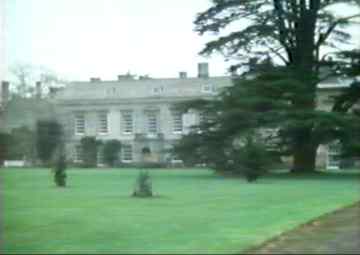 |
The Kommissar described Blake and Jenna as "resisters", ascribing their "condition" to a malfunction of the genes. He believed that only one person in ten thousand was a resister, most being detected in infancy.
|
Respirators were worn by Avon and Vila in The Harvest of Kairos, when
they went down on the permanant dark side of an unnamed planet and
collected Sopron. The type of respirator used was black and consisted of a
mask covering the nose and mouth, linked by two tubes with the respirator
proper, which was contained in a small box attached by straps to the
wearer's chest. The use of the respirators presumed that conditions on the planet's surface were such that the atmosphere was unbreathable, though with tolerable pressure. | 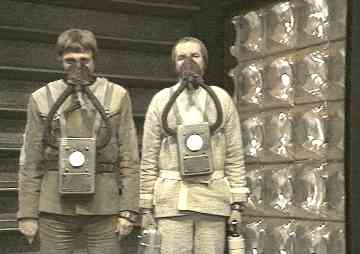 |
Vila briefly extolled the more appealing (to him) features of Federation rest centres, including sensory ecstasy hours and pleasure machines.